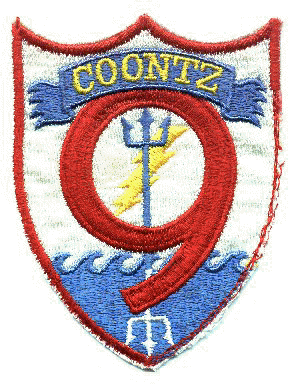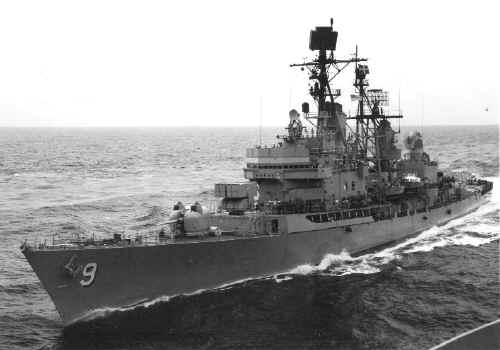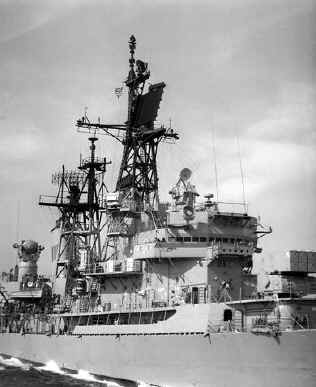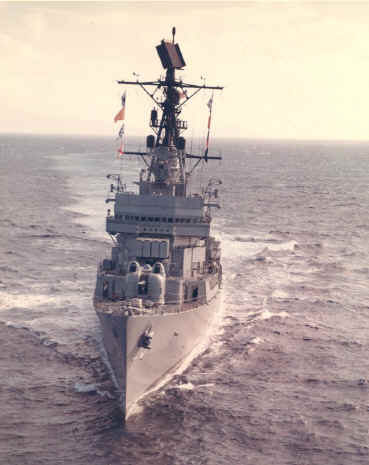|

Aegean Decision
By LCDR Mike Snyder, USN(ret)
At the time of this story, LCDR Snyder was LT(jg)
and the Missile Officer (1973-1974)
U.S.S. COONTZ (DLG-9)
 If
we stand on we’re going to run aground!
I came to that conclusion as I stood on the bridge of USS Coontz (DLG-9)
in the northwest corner of the Aegean Sea. My
ship had been banished to this little-traveled piece of the Aegean to get well
after failing a Propulsion Examining Board (PEB) review. If
we stand on we’re going to run aground!
I came to that conclusion as I stood on the bridge of USS Coontz (DLG-9)
in the northwest corner of the Aegean Sea. My
ship had been banished to this little-traveled piece of the Aegean to get well
after failing a Propulsion Examining Board (PEB) review.
The board had inspected us in the week before
a port visit to Piraeus, port of call for Athens, and found us deficient in some
arcane aspect of engineering. I
was not directly involved but I know the CO and the Chief Engineer were really
pissed. They felt they had been
royally screwed. The PEB had only
recently come into being and this was the first time Coontz had been inspected.
We were a 1200 PSI steam ship and thus among the first on the hit list.
The inspection party came aboard at sea like Nazi storm
troopers. They were unsmiling and
arrogant. The first words out of
the team leaders mouth, a captain, when he met the CO on the bridge was, “Why
didn’t you meet me on the quarterdeck?”
The CO rightfully replied he felt his place was on the bridge during sea
and anchor detail. It was all
downhill from there.
To a man, the PEB
team was distinctly unfriendly. They
operated under the auspices of the Board of Inspection and Survey (INSURV) and
were not responsible to the ships operational or type commander.
These guys were autonomous and, as it was shown later, out of control.
At the time it seemed their entire focus was to demonstrate their
authority while decertifying as many ships as possible.
They carried a real chip on the shoulder attitude.
It was truly an incongruous situation.
Coontz, an operational ship on deployment in the Mediterranean with fleet
and political commitments, was being told it was incapable of properly steaming
the plant. With the report written
and delivered, the Nazis left the ship and Coontz was banished to the northern Aegean
like a dog thrown out of the house for messing on the floor.
We didn’t get to visit Piraeus and Athens this go-around.
go-around.
Up and down, back and forth we steamed
running every kind of engineering exercise known to man. The entire ships company was dedicated
to helping the engineers out of this personal crisis.
Engineers were relieved from all routine, non-engineering duty. Other departments provided administrative assistance and
manpower where ever it was needed. Meals
were provided at odd hours, conforming to the exercise schedule.
Sensitive electronics equipment was kept in standby or off to allow the
unrestricted imposition of casualties. Passageways
were cleared to give emergency teams unobstructed access to all parts of the
ship. The engineers and the rest of the ship worked hard to regain
our good standing. To me, it
appeared that real progress was made.
At the end of two weeks we headed south to rejoin the
Mediterranean fleet. Having been
duly chastised we were being  allowed
to again move among the untainted. Enroute
the ship had to traverse a choke point between the islands of Skopelos on the
west and Alonnisos on the east. I
relieved the OOD of the deck and the conn for the evening watch at about 1945. It was just before dusk.
The situation was calm but not good.
Radar and visual fixes accurately told me the ship was positioned several
miles north of Alonnisos. An
unbroken line of ships streamed north out of the narrow passage past our
starboard beam. A mile beyond was
an equally crowded sea-lane of southbound ships.
We steamed slowly south at 5 or 6 knots in clear air and smooth seas.
I had orders not to change course or
speed.
The off-going OOD was the ships navigator.
I was sufficiently uncomfortable that I kept him and his JOOD on the
bridge to perform as expert lookouts and to assist and advise me.
If the ship continued to move along its track we would
run aground in a half hour. allowed
to again move among the untainted. Enroute
the ship had to traverse a choke point between the islands of Skopelos on the
west and Alonnisos on the east. I
relieved the OOD of the deck and the conn for the evening watch at about 1945. It was just before dusk.
The situation was calm but not good.
Radar and visual fixes accurately told me the ship was positioned several
miles north of Alonnisos. An
unbroken line of ships streamed north out of the narrow passage past our
starboard beam. A mile beyond was
an equally crowded sea-lane of southbound ships.
We steamed slowly south at 5 or 6 knots in clear air and smooth seas.
I had orders not to change course or
speed.
The off-going OOD was the ships navigator.
I was sufficiently uncomfortable that I kept him and his JOOD on the
bridge to perform as expert lookouts and to assist and advise me.
If the ship continued to move along its track we would
run aground in a half hour.
I called the wardroom, disturbing
the CO as he watched the movie. I
described the entire situation, emphasizing the proximity of the island. Expecting him to come to the bridge I carried on.
In a few minutes, when he didn’t arrive, I called
again this time with an edge on my voice that I was sure would alert him.
I reiterated the dangerous situation we were standing into, giving him
the relative position of ships near us. Nothing.
He didn’t show.
The third time I
called I was insistent saying I had to turn the ship. With many years of hindsight I know now I should have said,
“Captain, I need you on the bridge!” But
I didn’t. Still, he failed to
come to the bridge following the third call in fifteen minutes and I determined
to take things into my own hands. Conning
by seaman’s eye, I picked a hole and ordered, “All ahead two thirds, right
full rudder”.
The ship heeled slightly and made a neat right angle turn to starboard.
At 10 or 12 knots we passed through the northbound traffic.
In the median I pivoted strongly left, slowed, and smoothly merged into
the southbound lane. As
I took off the speed and steadied on course the CO hurried onto the bridge.
He had heard the forced draft blowers spin up and felt the turn. I
reported our situation, gave him a visual tour of the immediate surroundings,
and proceeded through the choke point. I
was sweating bullets not out of fear of the CO, but in response to the tense and
dangerous situation I had just taken the ship through.
The captain stayed on the bridge, sitting in his big chair, throughout most
of the remainder of the watch. He
said nothing.
blowers spin up and felt the turn. I
reported our situation, gave him a visual tour of the immediate surroundings,
and proceeded through the choke point. I
was sweating bullets not out of fear of the CO, but in response to the tense and
dangerous situation I had just taken the ship through.
The captain stayed on the bridge, sitting in his big chair, throughout most
of the remainder of the watch. He
said nothing.
Next morning I was back on deck for the
forenoon watch. After
breakfast and working his way through the “skeds”, the unedited run of
message traffic, the captain walked out on the starboard bridge wing, directing me to
follow. He asked, “What
went on here last night?” I took a deep breath and explained that after calling him
three times I had to take action or run aground.
I told him about retaining the navigator as an advisor and his JOOD as a
lookout. Then I
said, “I’ve never felt so alone or so abandoned as I did on this bridge last
night. You
failed me when I needed you.”
The expression on his face changed to something between surprise and
grimace but he said nothing. After
a few thoughtful moments he whispered, “OK”.
That was the end of it. Neither
of us spoke of the incident again. I
guess it really was “OK” because my fitness reports did not take a nosedive
in the responsibility or loyalty rows and I continued in my position as fleet
OOD for the remainder of the time he was aboard.
I took a lesson though.
I was never again ambiguous in my reports to, or my expression
of needs from, any CO.

 

|
